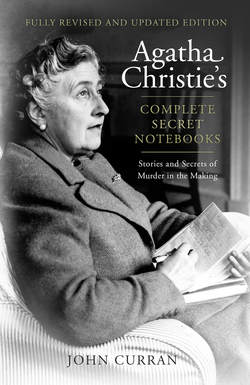Читать книгу Agatha Christie’s Complete Secret Notebooks - Агата Кристи, Agatha Christie, Detection Club The - Страница 30
… it often stimulates me, if not to write that identical plot at least to write something else …
ОглавлениеThroughout her career one of Christie’s greatest gifts was her ability to weave almost endless variations on seemingly basic ideas. Murderous alliances, the eternal triangle, victim-as-murderer, disguise – down the years she used and reused all these ploys to confound reader expectation. So when she writes about being stimulated to write ‘something else’ we know that she could do this effortlessly. Something as seemingly unimportant or uninspiring as the word ‘teeth’ could inspire her and, in fact, she used that very idea in at least two novels: One, Two, Buckle my Shoe and, as a minor plot element, in The Body in the Library.
Identical twins (one killed in railway smash) survivor – claims to be the rich one (teeth?)
Poor little rich girl – house on hill – luxury gadgets etc. – original owner
Stamp idea – man realises fortune – puts it on old letter – a Trinidad stamp on a Fiji letter
Old lady in train variant – a girl is in with her – later is offered a job at the village – takes it
As we shall see, the ‘Stamp idea’ features in a short story and a play over 15 years apart; the ‘Old lady in train’ ploy appears in two novels almost 20 years apart; and the ‘Poor little rich girl’ inspired a short story and, 25 years later, a novel.
Finally, it is a major disappointment that there remains nothing from the creation of two of Christie’s most famous titles: The Murder of Roger Ackroyd and Murder on the Orient Express. About the latter we know absolutely nothing, as it is not mentioned even in passing. Notebook 67 does have an incomplete list of characters from The Murder of Roger Ackroyd but nothing more. There is, however, some background to its creation contained in an intriguing correspondence with Lord Mountbatten of Burma.
In a letter dated 28 March 1924 Mountbatten wrote to ‘Mrs Christie, Author of The Man who was No. 4, c/o The Sketch’ (this was a reference to the recently finished serial publication of The Big Four in that magazine). Writing in the third person, he expressed his admiration for Poirot and Christie and begged to offer an idea for a detective story. He explained that, although he had had a few stories published under a pseudonym, his career at sea did not leave a lot of time for writing.
Briefly, his idea was that Hastings, before he leaves for South America, should introduce a friend, Genny, to Poirot. When a murder occurs Poirot writes to inform Hastings and explains that Genny will write subsequent letters keeping him abreast of developments. The plot involves the drugging of the victim to appear dead; when the body is ‘discovered’, the murderer stabs him. Genny’s alibi appears impeccable as he is with Poirot until the discovery. Only in the final chapter is Genny unmasked as the killer. As can be seen, Christie retained the underlying suggestion, the narrator/murderer idea. All the surrounding detail, however, was her embroidery on his basic pattern.
On 26 November 1969 Mountbatten wrote again to congratulate Christie on The Mousetrap’s seventeenth birthday. She replied within the week and apologised in case she had not acknowledged his suggestion of 45 years earlier (he subsequently assured her that she had), thanked him for his kind words and enclosed her latest book, Hallowe’en Party (‘not as good as Roger Ackroyd but not too bad’). She also mentioned that her brother-in-law, James, had suggested a similar narrator/murderer plot to her around the same time, although she had thought then that it would be very difficult to carry off.
